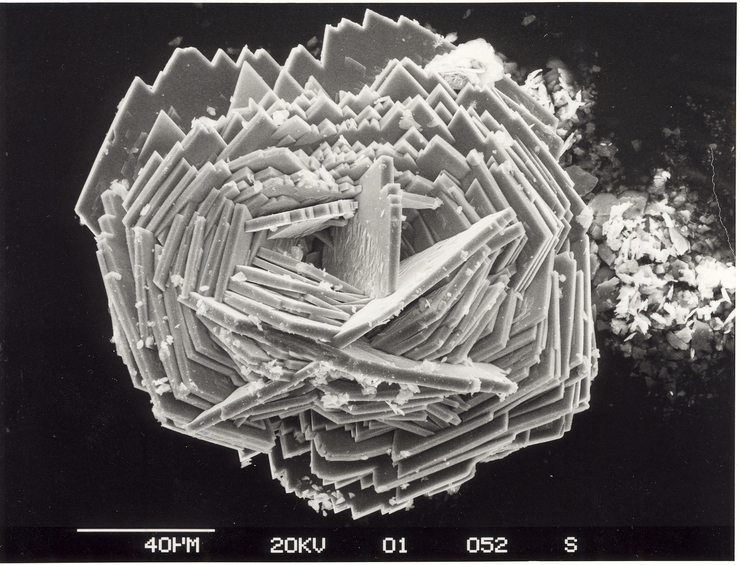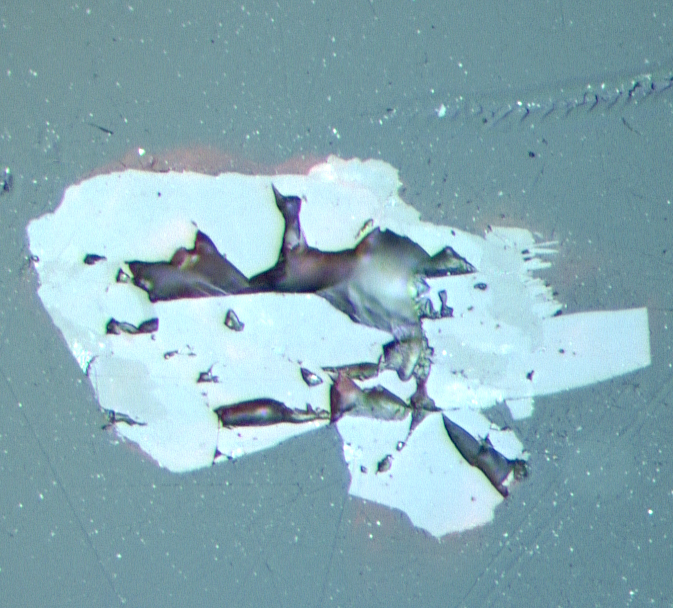Sewardite
A valid IMA mineral species
This page is currently not sponsored. Click here to sponsor this page.
About Sewardite
Formula:
CaFe3+2(AsO4)2(OH)2
Colour:
Dark red to light orange
Lustre:
Vitreous
Hardness:
3½
Specific Gravity:
4.156 (Calculated)
Crystal System:
Orthorhombic
Member of:
Name:
Named in honour of Terry Maxwell Seward (b. 1940), Canadian geochemist, Professor of Geochemistry, Institut für Mineralogie und Petrographie, ETH (Swiss Federal Institute of Technology), Zürich, Switzerland. Seward’s research focuses on the chemistry of fluids on and in the earth’s crust, including low temperature aqueous systems, metal speciation, dispersion of heavy metals connected with toxic waste disposal and sea-floor hydrothermal systems. He collected the type material 20 years before the description was published.
Unique Identifiers
Mindat ID:
11128
Long-form identifier:
mindat:1:1:11128:7
GUID
(UUID V4):
(UUID V4):
945ac242-3292-4007-b6bc-1ecbbf4cc12d
Classification of Sewardite
Approved
First published:
2002
8.BH.30
8 : PHOSPHATES, ARSENATES, VANADATES
B : Phosphates, etc., with additional anions, without H2O
H : With medium-sized and large cations, (OH,etc.):RO4 = 1:1
8 : PHOSPHATES, ARSENATES, VANADATES
B : Phosphates, etc., with additional anions, without H2O
H : With medium-sized and large cations, (OH,etc.):RO4 = 1:1
Mineral Symbols
As of 2021 there are now IMA–CNMNC approved mineral symbols (abbreviations) for each mineral species, useful for tables and diagrams.
| Symbol | Source | Reference |
|---|---|---|
| Sew | IMA–CNMNC | Warr, L.N. (2021). IMA–CNMNC approved mineral symbols. Mineralogical Magazine, 85(3), 291-320. doi:10.1180/mgm.2021.43 |
Pronunciation of Sewardite
Pronunciation:
| Play | Recorded by | Country |
|---|---|---|
| Jolyon & Katya Ralph | United Kingdom |
Physical Properties of Sewardite
Vitreous
Transparency:
Transparent, Translucent
Colour:
Dark red to light orange
Streak:
Reddish-brown
Hardness:
3½ on Mohs scale
Tenacity:
Brittle
Fracture:
Irregular/Uneven, Splintery
Density:
4.156 g/cm3 (Calculated)
Optical Data of Sewardite
Bireflectance:
Very weak.
Reflectivity:
| Wavelength | R1 | R2 |
|---|---|---|
| 400nm | 10.50% | 11.12% |
| 420nm | 10.43% | 11.05% |
| 440nm | 10.32% | 10.92% |
| 460nm | 10.12% | 10.71% |
| 470nm | 10.04% | 10.60% |
| 480nm | 9.96% | 10.49% |
| 500nm | 9.78% | 10.37% |
| 520nm | 9.69% | 10.18% |
| 540nm | 9.53% | 10.07% |
| 546nm | 9.49% | 10.06% |
| 560nm | 9.40% | 10.02% |
| 580nm | 9.30% | 9.98% |
| 589nm | 9.27% | 9.95% |
| 600nm | 9.24% | 9.92% |
| 620nm | 9.15% | 9.80% |
| 640nm | 8.99% | 9.66% |
| 650nm | 8.80% | 9.49% |
| 660nm | 8.60% | 9.37% |
| 680nm | 7.89% | 8.87% |
| 700nm | 7.25% | 8.30% |
Graph shows reflectance levels at different wavelengths (in nm). Top of box is 100%. Peak reflectance is 11.12%.
R1 shown in black, R2 shown in red
Colour in reflected light:
Light bluish grey.
Internal Reflections:
Ubiquitous, very bright pink to red.
Pleochroism:
Non-pleochroic
Chemical Properties of Sewardite
Formula:
CaFe3+2(AsO4)2(OH)2
Crystallography of Sewardite
Crystal System:
Orthorhombic
Class (H-M):
mmm (2/m 2/m 2/m) - Dipyramidal
Space Group:
Cccm
Cell Parameters:
a = 16.461 Å, b = 7.434 Å, c = 12.131 Å
Ratio:
a:b:c = 2.214 : 1 : 1.632
Unit Cell V:
1,484.48 ų (Calculated from Unit Cell)
Crystal Structure
Load
Unit Cell | Unit Cell Packed
2x2x2 | 3x3x3 | 4x4x4
Unit Cell | Unit Cell Packed
2x2x2 | 3x3x3 | 4x4x4
Show
Big Balls | Small Balls | Just Balls | Spacefill
Polyhedra Off | Si Polyhedra | All Polyhedra
Remove metal-metal sticks
Big Balls | Small Balls | Just Balls | Spacefill
Polyhedra Off | Si Polyhedra | All Polyhedra
Remove metal-metal sticks
Display Options
Black Background | White Background
Perspective On | Perspective Off
2D | Stereo | Red-Blue | Red-Cyan
Black Background | White Background
Perspective On | Perspective Off
2D | Stereo | Red-Blue | Red-Cyan
View
CIF File Best | x | y | z | a | b | c
CIF File Best | x | y | z | a | b | c
Rotation
Stop | Start
Stop | Start
Labels
Console Off | On | Grey | Yellow
Console Off | On | Grey | Yellow
Data courtesy of the American Mineralogist Crystal Structure Database. Click on an AMCSD ID to view structure
| ID | Species | Reference | Link | Year | Locality | Pressure (GPa) | Temp (K) |
|---|---|---|---|---|---|---|---|
| 0005788 | Sewardite | Roberts A C, Cooper M A, Hawthorne F C, Criddle A J, Stirling J A R (2002) Sewardite, CaFe2(AsO4)2(OH)2, the Ca-analogue of carminite, from Tsumeb, Namibia: Description and crystal structure The Canadian Mineralogist 40 1191-1198 |  | 2002 | Tsumeb, Namibia | 0 | 293 |
CIF Raw Data - click here to close
X-Ray Powder Diffraction
Powder Diffraction Data:
| d-spacing | Intensity |
|---|---|
| 4.874 Å | (90) |
| 3.473 Å | (50) |
| 3.389 Å | (60) |
| 3.167 Å | (100) |
| 3.015 Å | (50) |
| 2.988 Å | (50) |
| 2.919 Å | (70) |
| 2.503 Å | (90) |
| 1.775 Å | (50) |
Geological Environment
Paragenetic Mode(s):
| Paragenetic Mode | Earliest Age (Ga) |
|---|---|
| Stage 7: Great Oxidation Event | <2.4 |
| 47a : [Near-surface hydration of prior minerals] | |
| 47d : [Arsenates, antimonates, selenates, bismuthinates] |
Type Occurrence of Sewardite
General Appearance of Type Material:
Platy to compact anhedral to subhedral masses, up to 0.3 mm in maximum size.
Place of Conservation of Type Material:
Systematic Reference Series of the National Mineral Collection at the Geological Survey of Canada, Ottawa, Ontario, 68095.
The Natural History Museum, London, Great Britain, BM 2001.36.
The Natural History Museum, London, Great Britain, BM 2001.36.
Associated Minerals at Type Locality:
Synonyms of Sewardite
Other Language Names for Sewardite
Relationship of Sewardite to other Species
Member of:
Other Members of this group:
| Carminite | PbFe3+2(AsO4)2(OH)2 | Orth. mmm (2/m 2/m 2/m) : Cccm |
| Crimsonite | PbFe3+2(PO4)2(OH)2 | Orth. mmm (2/m 2/m 2/m) : Cccm |
Common Associates
Associated Minerals Based on Photo Data:
| 9 photos of Sewardite associated with Carminite | PbFe3+2(AsO4)2(OH)2 |
| 4 photos of Sewardite associated with Arseniosiderite | Ca2Fe3+3(AsO4)3O2 · 3H2O |
Related Minerals - Strunz-mindat Grouping
| 8.BH. | Crimsonite | PbFe3+2(PO4)2(OH)2 |
| 8.BH. | Plumboperloffite | PbMn2+2Fe3+2(PO4)3(OH)3 |
| 8.BH. | Reznitskyite | CaMg(VO4)F |
| 8.BH. | Cuprozheshengite | Pb4CuZn2(AsO4)2(PO4)2(OH)2 |
| 8.BH. | Zheshengite | Pb4ZnZn2(AsO4)2(PO4)2(OH)2 |
| 8.BH.05 | Thadeuite | Ca(Mg,Fe2+)3(PO4)2(OH,F)2 |
| 8.BH.10 | Durangite | NaAl(AsO4)F |
| 8.BH.10 | Isokite | CaMg(PO4)F |
| 8.BH.10 | Lacroixite | NaAl(PO4)F |
| 8.BH.10 | Maxwellite | NaFe3+(AsO4)F |
| 8.BH.10 | Panasqueiraite | CaMg(PO4)(OH,F) |
| 8.BH.10 | Kononovite | NaMg(SO4)F |
| 8.BH.10 | Arsenatrotitanite | NaTi(AsO4)O |
| 8.BH.15 | Drugmanite | Pb2(Fe3+,Al)(PO4)(PO3OH)(OH)2 |
| 8.BH.20 | Bjarebyite | (Ba,Sr)(Mn2+,Fe2+,Mg)2Al2(PO4)3(OH)3 |
| 8.BH.20 | Cirrolite | Ca3Al2(PO4)3(OH)3 (?) |
| 8.BH.20 | Kulanite | Ba(Fe2+,Mn2+,Mg)2(Al,Fe3+)2(PO4)3(OH)3 |
| 8.BH.20 | Penikisite | Ba(Mg,Fe2+,Ca)2Al2(PO4)3(OH)3 |
| 8.BH.20 | Perloffite | Ba(Mn2+,Fe2+)2Fe3+2(PO4)3(OH)3 |
| 8.BH.20 | Johntomaite | BaFe2+2Fe3+2(PO4)3(OH)3 |
| 8.BH.20 | Strontioperloffite | SrMn2+2Fe3+2(PO4)3(OH)3 |
| 8.BH.25 | Bertossaite | (Li,Na)2(Ca,Fe2+,Mn2+)Al4(PO4)4(OH,F)4 |
| 8.BH.25 | Palermoite | (Li,Na)2(Sr,Ca)Al4(PO4)4(OH)4 |
| 8.BH.25 | Natropalermoite | Na2SrAl4(PO4)4(OH)4 |
| 8.BH.30 | Carminite | PbFe3+2(AsO4)2(OH)2 |
| 8.BH.35 | Adelite | CaMg(AsO4)(OH) |
| 8.BH.35 | Arsendescloizite | PbZn(AsO4)(OH) |
| 8.BH.35 | Austinite | CaZn(AsO4)(OH) |
| 8.BH.35 | Cobaltaustinite | CaCo(AsO4)(OH) |
| 8.BH.35 | Conichalcite | CaCu(AsO4)(OH) |
| 8.BH.35 | Duftite | PbCu(AsO4)(OH) |
| 8.BH.35 | Gabrielsonite | PbFe3+(As3+O3)O |
| 8.BH.35 | Nickelaustinite | CaNi(AsO4)(OH) |
| 8.BH.35 | Tangeite | CaCu(VO4)(OH) |
| 8.BH.35 | Duftite-alpha | PbCu(AsO4)(OH) |
| 8.BH.35 | Gottlobite | CaMg(VO4)(OH) |
| 8.BH.35 | Hermannroseite | CaCu(PO4)(OH) |
| 8.BH.40 | Čechite | PbFe2+(VO4)(OH) |
| 8.BH.40 | Descloizite | PbZn(VO4)(OH) |
| 8.BH.40 | Mottramite | PbCu(VO4)(OH) |
| 8.BH.40 | Pyrobelonite | PbMn2+(VO4)(OH) |
| 8.BH.40 | Khorixasite | (Bi0.67◻0.33)Cu(VO4)(OH) |
| 8.BH.45 | Bayldonite | PbCu3(AsO4)2(OH)2 |
| 8.BH.45 | Vésigniéite | BaCu3(VO4)2(OH)2 |
| 8.BH.50 | Paganoite | NiBi(AsO4)O |
| 8.BH.55 | Harrisonite | Ca(Fe2+,Mg)6(PO4)2(SiO4)2 |
| 8.BH.55 | Jagowerite | BaAl2(PO4)2(OH)2 |
| 8.BH.60 | Attakolite | CaMn2+Al4(SiO3OH)(PO4)3(OH)4 |
| 8.BH.65 | Leningradite | PbCu3(VO4)2Cl |
| 8.BH.70 | Katiarsite | KTiO(AsO4) |
| 8.BH.70 | Yurgensonite | K2SnTiO2(AsO4)2 |
| 8.BH.75 | Melanarsite | K3Cu7Fe3+O4(AsO4)4 |
| 8.BH.80 | Moraskoite | Na2Mg(PO4)F |
| 8.BH.80 | Evseevite | Na2Mg(AsO4)F |
| 8.BH.85 | Piccoliite | NaCaMn3+2(AsO4)2O(OH) |
Fluorescence of Sewardite
Not fluorescent.
Other Information
Health Risks:
No information on health risks for this material has been entered into the database. You should always treat mineral specimens with care.
Internet Links for Sewardite
mindat.org URL:
https://www.mindat.org/min-11128.html
Please feel free to link to this page.
Please feel free to link to this page.
Search Engines:
External Links:
Mineral Dealers:
References for Sewardite
Reference List:
Localities for Sewardite
Locality List
 - This locality has map coordinates listed.
- This locality has map coordinates listed.
 - This locality has estimated coordinates.
ⓘ - Click for references and further information on this occurrence.
? - Indicates mineral may be doubtful at this locality.
- This locality has estimated coordinates.
ⓘ - Click for references and further information on this occurrence.
? - Indicates mineral may be doubtful at this locality.
 - Good crystals or important locality for species.
- Good crystals or important locality for species.
 - World class for species or very significant.
(TL) - Type Locality for a valid mineral species.
(FRL) - First Recorded Locality for everything else (eg varieties).
- World class for species or very significant.
(TL) - Type Locality for a valid mineral species.
(FRL) - First Recorded Locality for everything else (eg varieties).
All localities listed without proper references should be considered as questionable.
France | |
| |
| |
Greece | |
| |
Mexico | |
| |
| |
| |
Namibia (TL) | |
| |
Turkey | |
| |
USA | |
|
Quick NavTopAbout SewarditeUnique IdentifiersClassification Mineral SymbolsPronunciation Physical Properties Optical Data Chemical Properties Crystallography Crystal StructureX-Ray Powder DiffractionGeological EnvironmentType Occurrence SynonymsOther LanguagesRelationshipsCommon AssociatesStrunz-MindatFluorescence Other InformationInternet Links References Localities Locality List







 symbol to view information about a locality.
The
symbol to view information about a locality.
The 



Ojuela Mine, Mapimí, Mapimí Municipality, Durango, Mexico